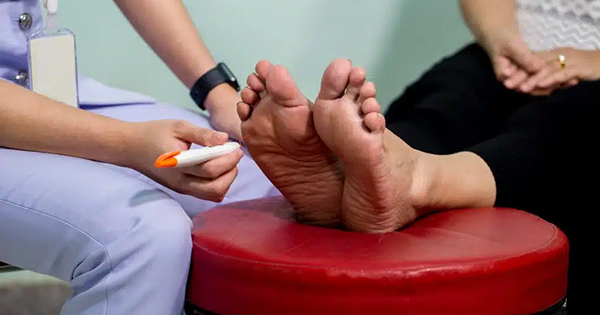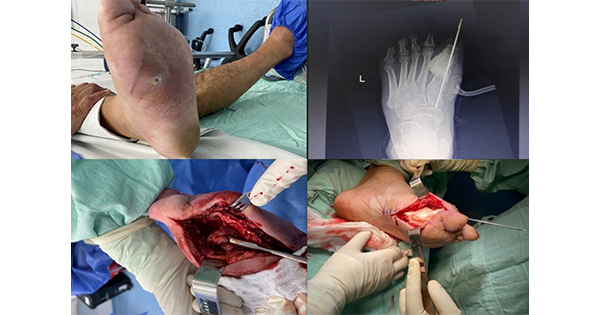I recently had the opportunity to engage in a debate with Professor Mike Edmonds as part of the English Diabetic Footcare Network programme entitled: “This house believes that the multidisciplinary foot team (MDFT) should only be held in secondary care.” I was against the motion.
Prof Edmonds gave a very strong argument for the need for a co-ordinated multidisciplinary approach to the management of diabetic foot complications and, indeed, won the debate by 53 to 47%, however, I think having the debate has really focussed thought on how we should start to manage the future of diabetic foot disease. We are overwhelmed with patients and we are living in a very different landscape to the early 1980s when Prof Edmonds developed the concept of the hospital MDFT. I used the analogy of Prof Edmonds being like Sir Alex Ferguson who came to Manchester United in 1986 and just like Prof who transformed the care and the outcomes for diabetic foot disease, Sir Alex transformed United from a poor team into a trophy-winning machine. Yet time moves on, football is different and United didn’t adapt, now languish near the bottom of the table and have poor infrastructure where even the roof leaks!
Diabetic foot disease has also changed. Diabetic foot problems remain a significant health challenge, yet the current care system is struggling to keep pace. While a multidisciplinary foot care service exists for patients with complex needs, gaps in access, funding and coordination continue to hinder progress. As the demand for specialised foot care increases, it is clear that modernisation is not just desirable — it is essential.
A healthcare system in transition
The Darzi Report (Department of Health and Social Care, 2024) underscored critical shortfalls in funding and staffing, warning of the growing strain on healthcare services. With patient numbers rising and resources stretched thin, diabetic foot care must evolve to meet future needs. The government’s proposed 10-year plan (NHS England, 2025) offers a vision of modernisation, long-term funding strategies, and structural reform — but will it deliver on its promises?
A landscape drastically changed
The challenges faced by diabetic foot care today are far greater than those of previous decades. There are more people living with diabetes than ever before, leading to an increase in foot ulcers, complex disease presentations and overall demand for care. The rise in cases has been accompanied by an alarming increase in amputations and early deaths, demonstrating the urgent need for better preventative measures and intervention strategies.
However, at a time when the need is greater than ever, staffing levels have declined and, anecdotally, motivation among healthcare workers is dwindling. The system is struggling not only with fewer specialists but also with reduced interest among professionals — adding another layer of complexity to an already overstretched workforce. If we do not act now, the consequences will be severe.
Lessons from the past and present
Looking back to 1986, podiatry was in its infancy. There were no podiatry degrees, no non-medical prescribing, and diabetic specialist roles were nearly non-existent. Today, advancements in digital health, non-medical prescribing and collaborative organisations, such as Foot in Diabetes UK (FDUK) and English Diabetes Footcare Network (EDFN) have reshaped the field. But are these developments keeping pace with the growing crisis?
Countries like Australia and the Netherlands have successfully modernised their healthcare systems through telemedicine, integrated care models and technological innovation. The UK must follow suit and leverage digitalisation, Electronic Health Records (EHR), and artificial intelligence (AI) to streamline workflows, improve diagnostics and predict complications before they arise.
The rise of virtual care models
One of the most promising advancements in healthcare is the emergence of virtual wards, which provide hospital-level care to patients in their own homes. NHS England has implemented a virtual ward-approach to support vulnerable and at-risk groups, ensuring patients receive timely interventions without unnecessary hospital admissions.
The North West London Virtual Hospital exemplifies the impact of virtual care. Between April 2022 and April 2023, 4,311 patients were managed through virtual ward pathways, saving an estimated 8,622 bed days and £3,448,800 in system costs. Similarly, in Australia, the Central Queensland foot hub virtual multidisciplinary team model of care has demonstrated how virtual healthcare can enhance diabetes-related foot disease management.
What must happen next
The future of diabetic foot care hinges on working smarter, not harder. The system must embrace digitalisation, AI-driven diagnostics and EHR integration to improve efficiency and patient outcomes. Equally crucial is patient activation and engagement, ensuring that individuals with diabetes are actively involved in their care through education and digital tools.
A community focused approach will bridge the gap between hospital and home-based care, ensuring that no patient is left behind. The podiatry profession must be upskilled, enabling practitioners to take on advanced roles, deliver higher-quality care, more focussed on the quality of treatment and the ability to move seamless through a system rather than a system that suits the clinicians in a secondary care setting. We need to increase the availability of community based diagnostics and expedite assessments and improve early intervention — saving lives and preventing unnecessary amputations.
The patient-centered future
Shorter waiting times, better access, and improved integration across emergency and general care are not luxuries — they are necessities. Special arrangements must be made for people with disabilities and those living in care settings to ensure equity in treatment.
The government’s long-term health plan presents an opportunity to drive meaningful change — but ambition alone is not enough. Investment, reform and collaboration are required to ensure diabetic foot care is modernised and equitable. If we fail to act, we risk leaving thousands of patients behind in a system that is no longer fit for purpose.
The question is not whether change is needed — it is whether we have the courage to enact it before the cracks in the system widen beyond repair.





